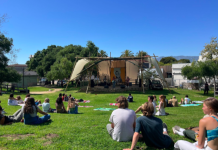Rishika Kenkre
Staff Writer
Nine nations in the Middle East are working together to develop a particle accelerator, known as Sesame. As a result of the political and social friction among the collaborating nations, Sesame, the electron synchrotron, has been in the works for twenty years.
The members of the project Sesame are Turkey, Israel, Iran, the Palestinian Authority, Egypt, Pakistan, Cyprus, Jordan, and Bahrain. Iran and Pakistan do not recognize Israel. Turkey does not recognize Cyprus. In any case, these nations are working together on Sesame.
First and foremost, Sesame is a particle accelerator. A particle accelerator is a machine in which charged atomic and subatomic particles are sped up by an alternating electric field as they undergo an outward spiral or circular path in a magnetic field. Being a synchrotron, Sesame is fueled by electrons moving in a circular path to produce energy.
Electron synchrotrons analyze the parts of materials. Hinged by huge magnets, the orbiting electrons let off radiation ranging from one end of the spectrum to the other. It can even probe through a wide variety of materials, such as biological tissue, or, in some cases, metal. Traveling with more velocity and deeper than other apparati, Sesame enables researchers to gather data quickly and with fewer materials.
Although there are around 60 electron synchrotrons in the world, this is the first in the Middle East. Even though they are expensive, the cost of constructing Sesame is significantly lower than those in other nations. According to The Economist, Diamond Light Source of Britain cost £260 million ($330 million), compared to only $79 million in the Middle East. This results from the availability of cheap labor and the innovations of Sesame’s creators.
This enterprise started when Abdus Salam, a Nobel-prize winning physicist, proposed that a synchrotron be constructed in the Middle East. Approximately twenty-five years later, his groundwork is being realized. According to The Economist, physicists Herman Winick and Gustav-Adolf advocated for moving BESSY I from Berlin, having it relocated and replaced.
Instead of following the Winick-Adolf suggestion, it was decided that the accelerator would be built from scratch. BESSY I would have functioned as a booster, giving electrons a start before coming into full motion in the main ring. This, in of itself, could have potentially saved the project about $4 million.
It has been difficult for the creators to raise enough to purchase all the resources for the particle accelerator. Due to fear of sanctions made by the U.S., banks refused to handle money coming from Iran. According to The Economist, every single member of the project agreed to contribute funds. Regardless, the money has come together with $48 million from the nine members and an additional $10 million contributed by the EU. Part of this capital has been utilized to supervise the building of the corralling magnets. The project creators are also hoping to make this particle accelerator run on solar power to reduce the operational costs.
Sesame’s electrons will consist of 2.5 billion electronvolts, units used to describe energy. With Einstein’s research of the relationship between energy, mass, and the speed of light, e=mc2, it signifies that an electron traveling around Sesame’s ring will weigh 5,000 times more than one which is not moving. Sesame is able to convert that mass into kinetic energy.
Radiation coming from different points creates “beam” lines for tools such as X-ray crystallography. This apparatus will form two “beam” lines with one producing infrared light to a microscope and the other giving off X-rays through organic and inorganic samples. With the price tag of $15 million, two more beam lines are planned for the next three years. Interestingly, synchrotron radiation has been worked to read scrolls too fragile to handle by touch. Through this, Sesame allows history to be understood more clearly.
Another advantage that this machinery brings is that it serves as nonpartisan ground for scientists in the Middle East and has required massive efforts from different parts of the region. The Guardian found that since synchrotron’ radiation is so highly valued, it has the potential to encourage people to make the trip to observe and analyze the synchrotron.
Some hope to promote younger generations staying involved in this development so the synchrotron can generate expertise and research, benefiting all those involved.
















